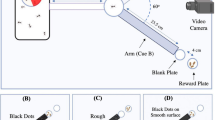Abstract
Adult pulmonate snails (Helix pomatia) were released equidistant between two types of food, carrot and potato, respectively. Naive snails moved in different directions and did not locate either food above chance, although both foods were readily eaten upon direct contact. After a single carrot feeding episode, 75% of the carrot-fed snails moved directly towards the carrot and ate it. Conversely, potato-fed snails located the potato in 67% of the cases. Snails that were fed apple or lettuce behaved like naive animals, with the majority of animals (75% in both cases) locating neither the carrot nor the potato.
The ability of snails to locate this particular food after a single feeding episode was maintained for at least 11 days, provided that the snails were not exposed to other foods in the interim. If the animals were fed a different food (but still tested for food-finding ability to the initially conditioned food) their orientation preference decreased gradually over a period of 5 days.
Although the snails' orientation is based upon olfactory cues, exposure to food odor alone is not sufficient to enable food-finding; additional feeding related stimuli are necessary.
These findings indicate that Helix do not possess a predisposition for the foods tested, and further suggest that processes underlying food-finding and food selection are strongly influenced by learning experiences. The conditioning phenomenon underlying food-finding behavior has been called Food-Attraction Conditioning, and appears to be a crucial link between the ecologies of learning and foraging behaviors. The accessibility of the snail's nervous system should permit neuronal analysis of the mechanisms underlying such a unique and complex learning phenomenon.
Similar content being viewed by others
References
Alkon DL (1985) Conditioning-induced changes of Hermissenda channels: relevance to mammalian brain function. In: Weinberger NM, McGaugh JL, Lynch G (eds) Memory systems of the brain. Guilford, New York, pp 9–26
Buddenbrock W von (1916) Einige Bemerkungen über den Lichtsinn der Pulmonaten. SB Heidelb Akad Wiss Math-Nat Kl; Biol Wiss Abh 1: 3–23
Burghardt GM, Hess EH (1966) Food imprinting in the snapping turtle, Chelydra serpentina. Science 151: 108–109
Capretta PJ (1977) Establishment of food preferences by exposure to ingestive stimuli early in life. In: Barker LM, Best MR, Domjan M (eds) Learning mechanisms in food selection. Baylor University, Waco pp 99–121
Chase R, Croll RP (1981) Tentacular function in snail olfactory orientation. J Comp Physiol 143: 357–362
Chase R (1982) The olfactory sensitivity of snails, Achatina fulica. J Comp Physiol 148: 225–235
Croll RP, Chase R (1977) A long-term memory for food odors in the land snail, Achatina fulica. Behav Biol 19: 261–268
Croll RP, Chase R (1980) Plasticity of olfactory orientation to foods in the snail Achatina fulica. J Comp Physiol 136: 267–277
Edelstam C, Palmer C (1950) Homing behaviour in gastropodes. Oikos 2: 259–270
Farkas SR, Shorey HH (1976) Anemotaxis and odour-trail following by the terrestrial snail Helix aspersa. Anim Behav 24: 686–689
Frömming E (1938) Untersuchungen über das Verhalten der Weinbergschnecke (Helix pomatia L.) gegenüber den Pflanzen, Früchten und höheren Pilzen. Arch Molluskenkd 70: 194–201
Frömming E (1950) Untersuchungen über die mengenmäßige Nahrungsaufnahme der Weinbergschnecke Helix pomatia. Arch Molluskenkd 79: 175–178
Gallistel CR (1990) The organization of memory. MIT, Cambridge
Garcia J, Hankins WG, Rusniak KW (1974) Behavioral regulation of the milieu interne in man and rat. Food preferences set by delayed visceral effects facilitate memory research and predator control. Science 185: 824–831
Garcia J, Hankins WG, Coil JD (1977) Koalas, men, and other conditioned gastronomes. In: Milgram NW, Krames K, Alloway TM (eds) Food aversion learning. Plenum, New York, pp 195–218
Gelperin A (1974) Olfactory basis of homing behavior in the giant garden slug, Limax maximus. Proc Natl Acad Sci USA 71: 966–970
Gelperin A (1975) Rapid food-aversion learning by a terrestrial mollusk. Science 189: 567–570
Gould JL (1986) The biology of learning. Annu Rev Psychol 37: 163–192
Hopfield JF, Gelperin A (1989) Differential conditioning to a compound stimulus and its components in the terrestrial mollusc Limax maximus. Behav Neurosci 103: 274–293
Hudson R (1993) Olfactory imprinting. Curr Opin Neurobiol 3: 548–552
Kamil AC, Roitblat HL (1985) The ecology of foraging behavior: implications for animal learning and memory. Annu Rev Psychol 36: 141–169
Kandel ER (1976) Cellular basis of behavior. Freeman, San Francisco
Lind H (1989) Homing to hibernation sites in Helix pomatia involving detailed long-term memory. Ethology 81: 221–234
Lind H (1990) Strategies of spatial behaviour in Helix pomatia Ethology 86: 1–18
MacPhail EM (1993) The neuroscience of animal intelligence. Columbia, New York
Milgram NW, Krames L, Alloway TM (eds) (1976) Food aversion learning. Plenum, New York
Newell PF (1966) The nocturnal behaviour of slugs. Med Biol Illustr 16: 146–159
Pickett JA, Stephenson JW (1980) Plant volatiles and components influencing behavior of the field slug. Deroceras reticulatum (Müll.). J Chem Ecol 6: 435–444
Sahley C, Gelperin A, Rudy JW (1981) One-trial associative learning modifies food odor preferences of a terrestrial mollusc. Proc Natl Acad Sci USA 78: 640–642
Schulz F (1938) Bau und Funktion der Sinneszellen in der Körperoberfläche von Helix pomatia. Z Morphol u Ökol Tiere 33: 555–581
Thorpe WH, Jones FGW (1937) Olfactory conditioning in a parasitic insect and its relation to the problem of host selection. Proc Roy Soc Lond B 124: 56–81
Willows AOD (1973) Learning in gastropod mollusks. In: Corning WC, Dyal JA, Willows AOD (eds) Invertebrate learning. Plenum, New York, pp 187–273
Author information
Authors and Affiliations
Rights and permissions
About this article
Cite this article
Teyke, T. Food-attraction conditioning in the snail, Helix pomatia . J Comp Physiol A 177, 409–414 (1995). https://doi.org/10.1007/BF00187477
Accepted:
Issue Date:
DOI: https://doi.org/10.1007/BF00187477




